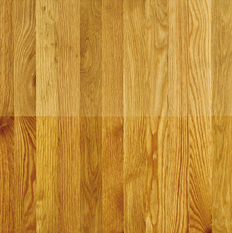Appearance
Color: Heartwood is
light brown; some boards may have a pinkish tint or a slight grayish
cast. Sapwood is white to cream.
Grain: Open, with longer rays than red oak.
Occasional crotches, swirls and burls. Plainsawn boards have a plumed
or flared grain appearance; riftsawn has a tighter grain pattern, low
figuring; quartersawn has a flake pattern, sometimes called tiger rays
or butt
Variations Within Species And Grades: Considerable
variation among boards in color and grain texture, but variations not
as pronounced as in red oak.
Properties
Hardness/Janka: 1360;
5% harder than Northern red oak.
Dimensional Stability: Average (change coefficient
.00365, 1% more stable than red oak).
Durability: More durable than red oak. Tannic acid in
the wood protects it from fungi and insects.
|
|
Workability
Sawing/Machining: Excellent
machining qualities.
Sanding: Good resistance to splitting;excellent
holding abilitiy.
Nailing: Good resistance to splitting; excellent
holding ability.
Finishing: Absorbs finishes more evenly than red oak.
Does not bleach well.
Comments: During the finishing process, tannins at
the surface can react with some liquids to turn wood gren or brown.
This effect tends to be more pronounced with products that have a high
water content, such as bleach and water-based finishes.
Cost
(relative to plainsawn select red
oak)
Multiplier: .95
Availability
Commodity item, available in
nearly all types, styles and sizes of flooring, including parquet,
strip, plank and veneer, both unfinished and prefinished.
|





